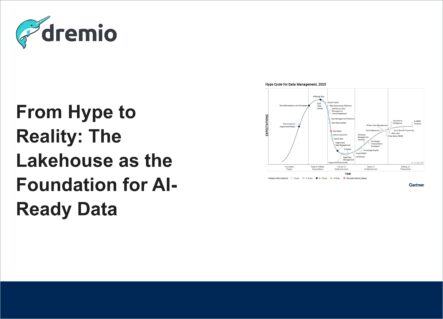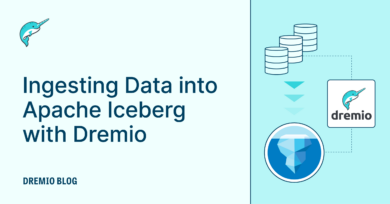4 minute read · September 16, 2025
From Hype to Reality: The Lakehouse as the Foundation for AI-Ready Data
· Head of DevRel, Dremio

Every year, the Gartner® Hype Cycle™ for Data Management helps us understand which technologies are generating buzz and which are delivering real business impact. In the 2024 report, one placement caught my attention: the data lakehouse has shifted from the Peak of Inflated Expectations into the Trough of Disillusionment.
At first glance, this might sound like a setback. But for those of us building and scaling lakehouses every day, it’s actually a milestone, one that shows the hype phase is behind us and the era of practical adoption is well underway.
Beyond the Hype Cycle Curve
The movement into the trough doesn’t mean the lakehouse model is losing relevance. Quite the opposite. It reflects what we’ve seen countless times before: once the industry hype fades, enterprises roll up their sleeves and focus on real-world implementation.
Think about it: we’re past the early promises, the bold predictions, and the pilot projects. The conversation is no longer “what is a lakehouse?” but “how do we make this architecture scale, govern it effectively, and deliver insights that drive business forward?”
Why the Lakehouse Is Different
Unlike some architectures that stall in the trough, the lakehouse has unique staying power. That’s because it’s built on open table formats like Apache Iceberg. These standards bring ACID transactions, schema evolution, and data versioning to cloud object storage, making the lakehouse more than a buzzword. It’s an architectural shift that unifies analytics and machine learning on a single foundation.
Organizations adopting lakehouses aren’t doing so because it’s trendy. They’re doing it because it solves practical challenges: lowering costs, breaking down silos, and enabling governed self-service access to data.
AI Raises the Stakes
At the same time, we’re in the middle of another hype cycle: Generative AI. Gartner notes that GenAI for data management is still embryonic but carries transformational potential. And here’s the connection: the success of AI initiatives depends entirely on the quality, accessibility, and openness of the underlying data.
Without a strong data foundation, AI projects struggle with trust, governance, and scale. The lakehouse fills this gap by providing a unified, open, and performance-optimized architecture that not only powers today’s analytics but also prepares organizations for tomorrow’s AI-ready data pipelines.
From Disillusionment to Acceleration
This is where I believe we are today: the trough isn’t a valley of failure, it’s the proving ground. Organizations that continue investing in their lakehouse strategies are emerging stronger, with architectures designed not just for dashboards but for agentic AI, retrieval-augmented generation (RAG), and future AI workloads.
At Dremio, we see customers every day moving beyond experiments and into production at scale. By combining Iceberg with intelligent query acceleration and autonomous performance management, we’re helping them unlock governed, self-service access to data, and set the stage for the next decade of AI innovation.
Closing Thoughts
The Gartner Hype Cycle shows that the lakehouse has moved past its initial hype, and that’s a good thing. It means the focus is now on outcomes, not marketing buzz.
For enterprises, this is the moment to lean in. By investing in open architectures and building AI-ready data foundations, organizations can turn “disillusionment” into a competitive edge. The lakehouse isn’t fading; it’s becoming the backbone of modern data and analytics, and the launchpad for the AI era.
Download the full report here.
Try Dremio’s Interactive Demo
Explore this interactive demo and see how Dremio's Intelligent Lakehouse enables Agentic AI


